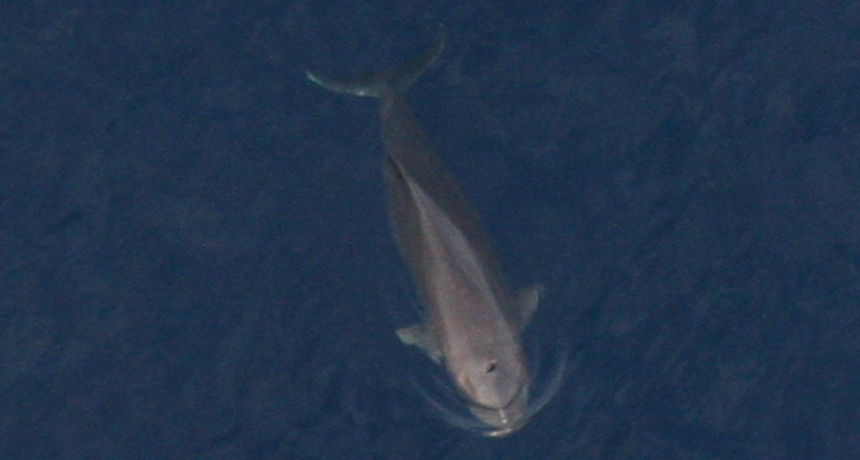Small sperm whale species share a diet

From the air, dwarf and pygmy sperm whales look similar. Their diets are similar, too, scientists have found.
UNCW/NOAA scientific permit No. 948-1692-00
- More than 2 years ago
Herman Melville may have made the sperm whale (Physeter macrocephalus) famous with Moby Dick, but there are other good reasons why you may not be familiar with the huge predator’s smaller cousins, the pygmy and dwarf sperm whales (Kogia breviceps and Kogia sima). Though they inhabit wide ranges and depths of temperate and tropical oceans along continental shelves and slopes, they are rarely sighted.
Scientists didn’t even recognize that the two species were separate until 1966. The pygmy species is a bit larger, and there are differences in morphology and genetics.
Dwarf and pygmy whales have been among the most commonly stranded marine mammals along the coast of Virginia and North Carolina. That gave three scientists from the University of North Carolina Wilmington a look at what the whales eat. Their study appears in the April Marine Mammal Science.
After marine mammals become stranded, their bodies are collected and necropsied, and the contents of their stomachs are saved. Michelle D. Staudinger and her colleagues looked through a stockpile of those stomachs, collected from 22 pygmy and 9 dwarf sperm whales from 1998 to 2011, and tallied up what the whales had been eating before they died.
Mostly the whales had been eating cephalopods, which Staudinger separated into species based on the hard beaks left behind after the soft bodies had been digested. To do that, she compared those beaks to her own reference samples (I guess there’s a collection for everyone) and to samples collected by whalers and fishermen over the last two centuries and now kept in the Smithsonian Institution.
The pygmy sperm whales had eaten 35 different species of cephalopod, and the dwarf sperm whales had consumed 13 species. A lone female pygmy sperm whale had a more varied diet, with two fish species — Sloane’s viperfish and Parin’s spinyfish— in her stomach. When she was left out of the analysis, the researchers found large overlap in diet between the two species.
They confirmed that overlap with analysis of the carbon and nitrogen isotopes in the whales’ muscle. Those isotopes reflect the food a creature has been eating, and they were also similar in the two sperm whale species.
“Overall, our results imply there is minimal niche partitioning between [the two] whales, thus shared food resources are likely not limited in offshore habitats of the mid-Atlantic region,” the researchers write.
The whales seem to have plenty of food for now, enough to share. But there is worry that that could change, particularly with climate change pushing some, but not all, species to move and upending established food webs. If that happens, the pygmy sperm whale will have a distinct advantage over its smaller brethren simply because of its larger bulk. Because the animals swallow their prey whole, the size of what a sperm whale can eat is dictated by the size of its esophagus. The pygmy sperm whale’s ability to eat larger prey could give it a leg up in the future, the researchers write.
Follow me on Twitter: @SarahZielinski






